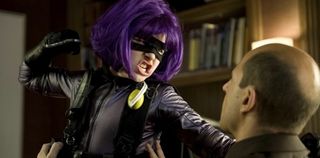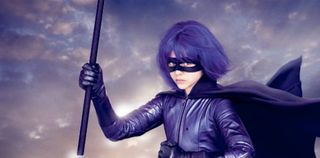Getting Away With Hit Girl: How Kick-Ass Lets You Root For An Adolescent Killer

The character never should have worked at all. Sure, in a comic book you can have children murdering people in cold blood and dropping c-bombs, but, you know, the movies aren't like 'Nam; there are rules. Clearly director Matthew Vaughn knew he had a major challenge in front of him when he chose to adapt Kick-Ass, and present the character of Hit Girl exactly as she was in the comic: an 11-year-old killing machine.
How did he pull it off? It's something you'll marvel over the entire time you watch Kick-Ass, wondering how Vaughn and his actress get away with making the audience watch, and actually root for, a pre-pubescent murderer. With a few exceptions (notably Roger Ebert and CB's own Josh Tyler), critics have embraced this pint-size dose of mayhem as a heroine, and even a feminist icon. So how did he do it? Taking the film step by step, and pretty much ignoring all the Kick-Ass parts (he matters less in the movie than you think), you can see exactly how it happened. Behold: The Evolution of Hit Girl, A Terrorizing Hero.
SPOILER WARNING: This article presumes you have seen Kick-Ass and discusses the ending in detail.

Step 1: Cast the right actress. Yes, Hit Girl existed in Mark Millar's original comic, but there was no way the character could have translated to the screen without a serious casting coup. Enter Chloe Moretz, an 11-year-old when they filmed the movie, and quite possibly the most confident onscreen adolescent since Jodie Foster. Moretz plays a girl who, yes, has had an unconventional childhood, but is more skilled and capable of handling the harsh realities of life than those of us who were treated to more normal educations, like, you know, kindergarten. Hit Girl isn't paranoid like her father, or insecure like Kick-Ass and Red Mist; she's a capable and fearless human who just happens to be pre-pubescent.

Step 2: Build the father-daughter relationship. Most superheroes are inspired to do-goodery by the death of a loved one, and that's where Big Daddy is coming from, but Hit Girl is motivated entirely by the love and encouragement of her adored father. Some girls bond with their fathers through fishing trips or the softball team; Hit Girl gets to spend quality time with her dad as he teaches her how to withstand a gunshot wound. From the moment we meet Big Daddy and Hit Girl, when she gamely gets back up after being shot in the chest and talks him into buying her an ice cream sundae, we see the amount of love and commitment between these two, even if what drives them is totally warped. And though in Hit Girl's first action scene she's on her own, her daddy is there with the sniper rifle to have her back. What more could you ask from a parent?

Step 3: Give her cartoon villains to fight. From that very first fight scene in the gangster lair, in which she proves she's got all the skills Big Daddy has instilled in her, Hit Girl is killing actual human beings, yes, but they're about as cartoonishly evil as you can imagine. The uninteresting villains are one of the downsides of Kick-Ass as a film-- couldn't they have come up with bad guys who didn't look like Sopranos extras?-- but it goes a long way toward the audience's acceptance of Hit Girl as an assassin. In movies we've always accepted murder by "good" characters when the victims were transparently bad, and though Kick-Ass ups the ante by making the killer an unrepentant 11-year-old, it's always clear that Hit Girl is on our team.

Step 4: Tell us that she's invincible. We first meet Hit Girl the fighter the moment she rescues Kick-Ass from certain gangster death, and we see her as he does-- dazzled. Though Kick-Ass is proven to be a vulnerable character, she isn't at all. As a movie Kick-Ass is exceptionally well paced, and Hit Girl's development follows the rule of three over her three fight scenes. First we meet her in the gangster lair and prove she's invincible, then we watch her rescue Big Daddy and Kick-Ass from torture and prove it again. The brutality of the torture scene is nothing like high-flying violence we've seen so far, nothing like Hit Girl's butterfly knives or the mobster in the microwave; this is real world violence, and it hurts. But with her clever strobe light and an ironclad will to rescue her father, Hit Girl proves not just that she's a fighter, but above even the most realistic, horrible violence we'll see in the film. Which sets us up perfectly for her third fight, the one that will break the rules.
CINEMABLEND NEWSLETTER
Your Daily Blend of Entertainment News

Step 5: Let her feel pain after all. After flying through a hallway packed with bad guys and vanquishing all of them, Hit Girl at last comes face to face with the Big Bad, Frank D'Amico-- and just like his goons tortured her father, he actually hurts her. For the first time in the movie we see the little girl behind Hit Girl's mask, whimpering after she's been punched in the face and slammed to the ground. It's difficult to watch, but crucial for the knowledge that Hit Girl is not invincible at all, but a little girl we need to root for like we would any other superhero with flaws. Just at the moment it would be easy to write off the character as escapist fantasy, we see the hurt in her eyes, and are brought to rooting for her all the harder to get the bad guy once and for all. The fact that Kick-Ass actually has to rescue Hit Girl this time is a key moment for his character, but also what we need to see her not just as a hero, but a character we've come to relate to.
Staff Writer at CinemaBlend
Most Popular








